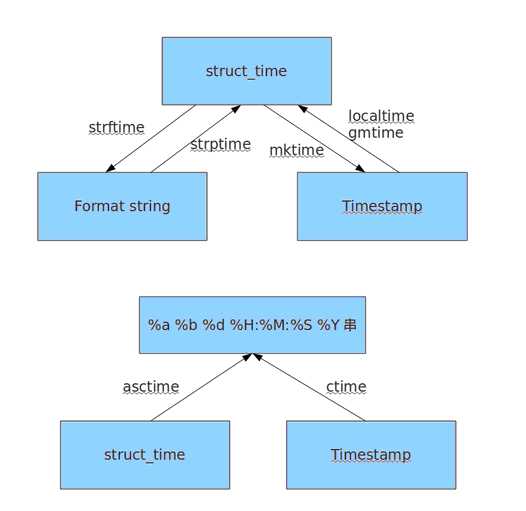python基础六
Posted
tags:
篇首语:本文由小常识网(cha138.com)小编为大家整理,主要介绍了python基础六相关的知识,希望对你有一定的参考价值。
模块
time &datetime模块
import time # print(time.clock()) #返回处理器时间,3.3开始已废弃 , 改成了time.process_time()测量处理器运算时间,不包括sleep时间,不稳定,mac上测不出来 # print(time.altzone) #返回与utc时间的时间差,以秒计算\\ # print(time.asctime()) #返回时间格式"Fri Aug 19 11:14:16 2016", # print(time.localtime()) #返回本地时间 的struct time对象格式 # print(time.gmtime(time.time()-800000)) #返回utc时间的struc时间对象格式 # print(time.asctime(time.localtime())) #返回时间格式"Fri Aug 19 11:14:16 2016", #print(time.ctime()) #返回Fri Aug 19 12:38:29 2016 格式, 同上 # 日期字符串 转成 时间戳 # string_2_struct = time.strptime("2016/05/22","%Y/%m/%d") #将 日期字符串 转成 struct时间对象格式 # print(string_2_struct) # # # struct_2_stamp = time.mktime(string_2_struct) #将struct时间对象转成时间戳 # print(struct_2_stamp) #将时间戳转为字符串格式 # print(time.gmtime(time.time()-86640)) #将utc时间戳转换成struct_time格式 # print(time.strftime("%Y-%m-%d %H:%M:%S",time.gmtime()) ) #将utc struct_time格式转成指定的字符串格式 #时间加减 import datetime # print(datetime.datetime.now()) #返回 2016-08-19 12:47:03.941925 #print(datetime.date.fromtimestamp(time.time()) ) # 时间戳直接转成日期格式 2016-08-19 # print(datetime.datetime.now() ) # print(datetime.datetime.now() + datetime.timedelta(3)) #当前时间+3天 # print(datetime.datetime.now() + datetime.timedelta(-3)) #当前时间-3天 # print(datetime.datetime.now() + datetime.timedelta(hours=3)) #当前时间+3小时 # print(datetime.datetime.now() + datetime.timedelta(minutes=30)) #当前时间+30分 # # c_time = datetime.datetime.now() # print(c_time.replace(minute=3,hour=2)) #时间替换

random模块
import random,string print(random.random()) print(random.randint(1,5)) print(random.randrange(1,5)) print("".join(random.sample(‘abcdef‘,2)))
以上代码运行结果:
0.030792454488319798
5
2
fa
生成随机4位数
方法一
import random,string str_source=string.ascii_letters+string.digits print("".join(random.sample(str_source,4)))
方法二
import random,string import random checkcode = ‘‘ for i in range(4): current = random.randrange(0,4) if current != i: temp = chr(random.randint(65,90)) else: temp = random.randint(0,9) checkcode += str(temp) print (checkcode)
os模块
os.getcwd() 获取当前工作目录,即当前python脚本工作的目录路径 os.chdir("dirname") 改变当前脚本工作目录;相当于shell下cd os.curdir 返回当前目录: (‘.‘) os.pardir 获取当前目录的父目录字符串名:(‘..‘) os.makedirs(‘dirname1/dirname2‘) 可生成多层递归目录 os.removedirs(‘dirname1‘) 若目录为空,则删除,并递归到上一级目录,如若也为空,则删除,依此类推 os.mkdir(‘dirname‘) 生成单级目录;相当于shell中mkdir dirname os.rmdir(‘dirname‘) 删除单级空目录,若目录不为空则无法删除,报错;相当于shell中rmdir dirname os.listdir(‘dirname‘) 列出指定目录下的所有文件和子目录,包括隐藏文件,并以列表方式打印 os.remove() 删除一个文件 os.rename("oldname","newname") 重命名文件/目录 os.stat(‘path/filename‘) 获取文件/目录信息 os.sep 输出操作系统特定的路径分隔符,win下为"\\\\",Linux下为"/" os.linesep 输出当前平台使用的行终止符,win下为"\\t\\n",Linux下为"\\n" os.pathsep 输出用于分割文件路径的字符串 os.name 输出字符串指示当前使用平台。win->‘nt‘; Linux->‘posix‘ os.system("bash command") 运行shell命令,直接显示 os.environ 获取系统环境变量 os.path.abspath(path) 返回path规范化的绝对路径 os.path.split(path) 将path分割成目录和文件名二元组返回 os.path.dirname(path) 返回path的目录。其实就是os.path.split(path)的第一个元素 os.path.basename(path) 返回path最后的文件名。如何path以/或\\结尾,那么就会返回空值。即os.path.split(path)的第二个元素 os.path.exists(path) 如果path存在,返回True;如果path不存在,返回False os.path.isabs(path) 如果path是绝对路径,返回True os.path.isfile(path) 如果path是一个存在的文件,返回True。否则返回False os.path.isdir(path) 如果path是一个存在的目录,则返回True。否则返回False os.path.join(path1[, path2[, ...]]) 将多个路径组合后返回,第一个绝对路径之前的参数将被忽略 os.path.getatime(path) 返回path所指向的文件或者目录的最后存取时间 os.path.getmtime(path) 返回path所指向的文件或者目录的最后修改时间
shelve模块
import shelve d= shelve.open(‘shelve_test‘) def stu_data(name,age): print("register stu",name,age) name = ["alex","rain","test"] info ={"name":"alex","age":22} d[‘test‘]=name d["info"]=info d["func"]=stu_data
d.close()
shutil模块
shutil.copyfileobj
将test.txt文件内容拷贝到另一个文件test.txt中,可以部分内容
import shutil f1=open("test.txt") f2=open("test_new.txt","w") shutil.copyfileobj(f1,f2)
将D:\\360.7z拷贝到D:\\test.7z
import shutil shutil.copyfile(r"D:\\360.7z",r"D:\\test.7z")
shutil.copy2
拷贝文件和状态信息
将D:\\360.7z拷贝到D:\\test.7z
import shutil shutil.copy2(r"D:\\360.7z",r"D:\\test.7z")
shutil.make_archive
将C:\\Downloads\\Tencent\\QQ下的内容打包到D:\\test2.tar.gz
import shutil ret=shutil.make_archive(r"d:\\test2","gztar",root_dir=r"C:\\Downloads\\Tencent\\QQ")
tarfile模块
C:\\QMDownload\\SoftMgr里面的内容装在zhou这个文件夹下打包到E:\\test1.tar
import tarfile tar = tarfile.open(r"E:\\test1.tar",‘w‘) tar.add(r"C:\\QMDownload\\SoftMgr",arcname="zhou") tar.close()
C:\\QMDownload\\SoftMgr里面的内容装在QMDownload\\SoftMgr这个文件夹打包到E:\\test2.tar
import tarfile tar = tarfile.open(r"E:\\test2.tar",‘w‘) tar.add(r"C:\\QMDownload\\SoftMgr") tar.close()
xml处理模块
xml是实现不同语言或程序之间进行数据交换的协议,跟json差不多,但json使用起来更简单,不过,古时候,在json还没诞生的黑暗年代,大家只能选择用xml呀,至今很多传统公司如金融行业的很多系统的接口还主要是xml。
xml的格式如下,就是通过<>节点来区别数据结构的:
<?xml version="1.0"?> <data> <country name="Liechtenstein"> <rank updated="yes">2</rank> <year>2008</year> <gdppc>141100</gdppc> <neighbor name="Austria" direction="E"/> <neighbor name="Switzerland" direction="W"/> </country> <country name="Singapore"> <rank updated="yes">5</rank> <year>2011</year> <gdppc>59900</gdppc> <neighbor name="Malaysia" direction="N"/> </country> <country name="Panama"> <rank updated="yes">69</rank> <year>2011</year> <gdppc>13600</gdppc> <neighbor name="Costa Rica" direction="W"/> <neighbor name="Colombia" direction="E"/> </country> </data>
xml协议在各个语言里的都 是支持的,在python中可以用以下模块操作xml
import xml.etree.ElementTree as ET tree = ET.parse("xmltest.xml") root = tree.getroot() print(root.tag) #遍历xml文档 for child in root: print(child.tag, child.attrib) for i in child: print(i.tag,i.text) #只遍历year 节点 for node in root.iter(‘year‘): print(node.tag,node.tex
修改和删除xml文档内容
import xml.etree.ElementTree as ET tree = ET.parse("xmltest.xml") root = tree.getroot() #修改 for node in root.iter(‘year‘): new_year = int(node.text) + 1 node.text = str(new_year) node.set("updated","yes") tree.write("xmltest.xml") #删除node for country in root.findall(‘country‘): rank = int(country.find(‘rank‘).text) if rank > 50: root.remove(country) tree.write(‘output.xml‘)
自己创建xml文档
import xml.etree.ElementTree as ET new_xml = ET.Element("namelist") name = ET.SubElement(new_xml,"name",attrib={"enrolled":"yes"}) age = ET.SubElement(name,"age",attrib={"checked":"no"}) sex = ET.SubElement(name,"sex") sex.text = ‘33‘ name2 = ET.SubElement(new_xml,"name",attrib={"enrolled":"no"}) age = ET.SubElement(name2,"age") age.text = ‘19‘ et = ET.ElementTree(new_xml) #生成文档对象 et.write("test.xml", encoding="utf-8",xml_declaration=True) ET.dump(new_xml) #打印生成的格式
ConfigParser模块
用于生成和修改常见配置文档,当前模块的名称在 python 3.x 版本中变更为 configparser。
来看一个好多软件的常见文档格式如下
[DEFAULT] ServerAliveInterval = 45 Compression = yes CompressionLevel = 9 ForwardX11 = yes [bitbucket.org] User = hg [topsecret.server.com] Port = 50022 ForwardX11 = no
如果想用python生成一个这样的文档怎么做呢?
import configparser config = configparser.ConfigParser() config["DEFAULT"] = {‘ServerAliveInterval‘: ‘45‘, ‘Compression‘: ‘yes‘, ‘CompressionLevel‘: ‘9‘} config[‘bitbucket.org‘] = {} config[‘bitbucket.org‘][‘User‘] = ‘hg‘ config[‘topsecret.server.com‘] = {} topsecret = config[‘topsecret.server.com‘] topsecret[‘Host Port‘] = ‘50022‘ # mutates the parser topsecret[‘ForwardX11‘] = ‘no‘ # same here config[‘DEFAULT‘][‘ForwardX11‘] = ‘yes‘ with open(‘example.ini‘, ‘w‘) as configfile: config.write(configfile)
读生成的文档里的内容
import configparser config= configparser.ConfigParser() print(config.sections()) config.read("example.ini") print(config.sections()) section_name=config.sections()[1] print(config[section_name]["host port"]) for i,v in config[section_name].items(): print(i,v)
以上代码运行结果
[] [‘bitbucket.org‘, ‘topsecret.server.com‘] 50022 host port 50022 forwardx11 no compressionlevel 9 compression yes serveraliveinterval 45
以上是关于python基础六的主要内容,如果未能解决你的问题,请参考以下文章